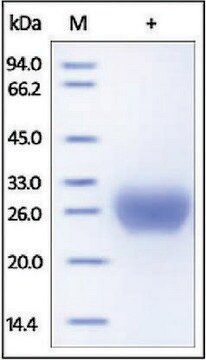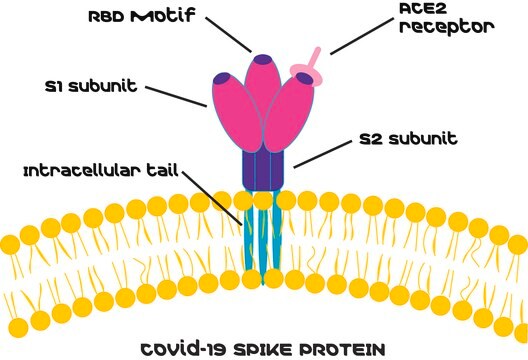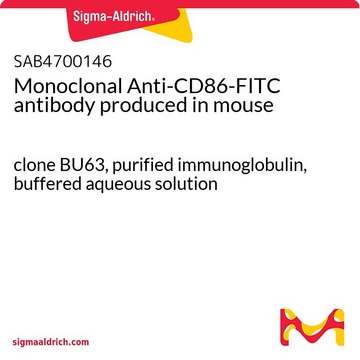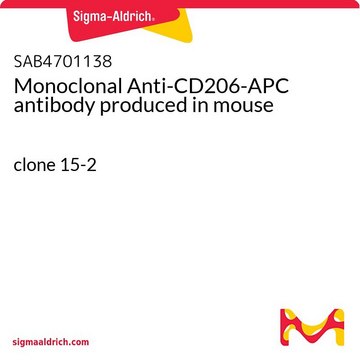일반 설명
Human CD16 or FCγRIII is a 50-70kDa membrane glycoprotein expressed by neutrophils, eosinophils, cultured monocytes, natural killer (NK) cells, tissue macrophages subpopulation, and on a small subset of T cells that binds aggregated but not monomeric human IgG. It is also known as FcR3, the low affinity receptor for complexed IgG. It comprises of two truncated Ig-like cytoplasmic domains.
Monoclonal Anti-CD16 (mouse IgG1 isotype) is derived from the 3G8 hybridoma produced by the fusion of mouse myeloma cells and splenocytes from an immunized CD2F1 mouse.
특이성
Recognizes the human CD16 antigen expressed on natural killer (NK) cells, granulocytes and a macrophage subpopulation. The antibody reacts with both NA1 and NA2 neutrophils and NK lymphocytes. It strongly labels neutrophils in tissue frozen sections. Liver Kupffer cells are weakly stained. The epitope recognized by the antibody seems to reside near the IgG binding site of FCγ-RIII. The antibody functionally blocks binding of soluble immune complexes to granulocytes and inhibits E-IgG rosettes. It induces Ca2+ increase in neutrophils.
면역원
viable human polymorphonuclear cells.
애플리케이션
Monoclonal Anti-CD16-FITC antibody is suitable for receptor blocking in flow cytometry analysis.
Monoclonal Anti-CD16-FITC antibody produced in mouse has been used in direct immunofluorescent staining.
생화학적/생리학적 작용
Cluster of differentiation 16 (CD16) induces Ca2+ increase in neutrophils. It strongly labels neutrophils in tissue frozen sections. Liver kupffer cells are weakly stained. The antibody functionally blocks binding of soluble immune complexes to granulocytes and inhibits E-IgG rosettes.
Human CD16 plays a pivotal role in immune responses by linking the humoral immune system with cellular effector functions. CD16 plays an important role in natural killer (NK)-cell function and in peripheral blood mononuclear cells (PBMCs). In the FcyRIII-expressing lymphocytes the NK cell activity is highly influenced through FcyRIII. CD16 exists as a transmembrane form in NK cells, macrophages and cultured monocytes with a 25 amino acid cytoplasmic tail which further connects with other receptors. The transmembrane form binds complexed IgG and mediates phagocytosis and antibody-dependent cellular cytotoxicity (ADCC).
표적 설명
CD16 antigen (also known as the low affinity receptor for complexed IgG, or Fcγ-RIII) expressed on natural killer (NK) cells, a macrophage sub-population and weakly on granulocytes. The human CD16 molecule exhibits two truncated Ig-like domains. In NK cells and macrophages, a trans-membrane form (50-80 kDa) with a 25 amino acid cytoplasmic tail is present. This form is non-covalently associated with other receptors (FcεRIγ or the TcRξ chain). The human CD16 molecule in granulocytes is a glycosyl-phosphatidyl-inositol (GPI)-linked form.
물리적 형태
Solution in 0.01 M phosphate buffered saline, pH 7.4, containing 1% bovine serum albumin and 15 mM sodium azide.
제조 메모
Prepared by conjugation to fluorescein isothiocyanate isomer I (FITC). This green dye is efficiently excited at 495 nm and emits at 525 nm.
면책조항
Unless otherwise stated in our catalog or other company documentation accompanying the product(s), our products are intended for research use only and are not to be used for any other purpose, which includes but is not limited to, unauthorized commercial uses, in vitro diagnostic uses, ex vivo or in vivo therapeutic uses or any type of consumption or application to humans or animals.









